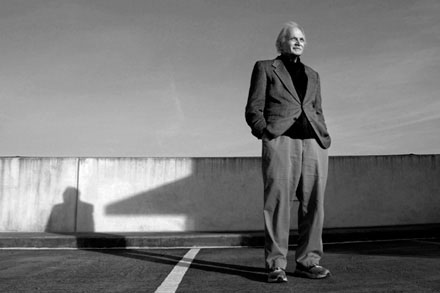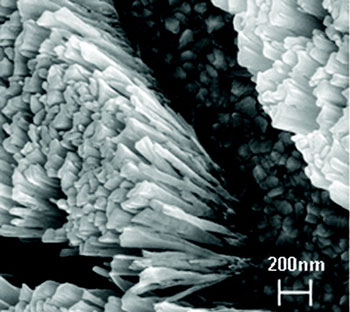Chemist Allen Bard looks to harness the power of sunlight to produce fuels that can substitute for oil.
 This is Part I of a two part series. Read Fueled by the Sun: Green Gold, to learn about efforts to make biofuels from plants and algae.
This is Part I of a two part series. Read Fueled by the Sun: Green Gold, to learn about efforts to make biofuels from plants and algae.
--
Al Bard has a dream. It’s in an area the size of Arizona blanketed in panels of iron oxide—rust—that have been doped with just the right mix of other elements. When the panels are hit by hot southwestern sunlight, they help split water into its constituent atoms, hydrogen and oxygen. The oxygen bubbles up into the air cleanly. The hydrogen is captured, and made available as fuel.
The benefit of such a fuel, if it emerges, will be considerable. It will be renewable into the far future, needing for its creation only water, air and modest amounts of metals, such as iron or titanium that we already have or can make in abundance. It will be much cleaner to produce than the hydrogen we currently make from methane, which produces carbon dioxide as a byproduct. It could, in fact, reduce emissions of carbon dioxide from oil refineries by as much as 40 percent.
What stands between this particular vision and us, however, is a gauntlet of photoelectrochemical challenges that Bard, one of the most decorated chemists on the planet, has been trying to overcome for the last decade.
“We do combinatorial chemistry,” says Bard, professor of chemistry and biochemistry. “In combinatorial chemistry, we say: I admit I have no idea what the best material will be. I have a kind of intuition based on past experience. I know what the colors of the materials are. I know what the spectral response to these things is. I know which are stable and not so stable. But really, the trick is to do it fast, to synthesize and screen quickly and get hits. The faster you can try them, and the more things you can try, the better you start to understand what you need. So that’s what we’re doing.”
Bard’s challenge is to find a material that can absorb as much light as possible in the right regions of the solar spectrum. It will have to be efficient in its use of the energy it absorbs. It will have to be electrically conductive. It will have to be sturdy. It will need to be able to use photons from the sun to excite electrons in the material and make them react with water.
And, perhaps most important, it will have to be cheap to make and cheap to lay down over tens of thousands of square miles of solar fuel farms. Because unless we can someday produce this clean hydrogen at prices comparable to what we pay now for hydrogen stripped from methane, then it won’t matter all that much. It won’t be bought, won’t be used, and will have no beneficial effect on atmospheric carbon dioxide.
“There’s no magic bullet,” says Bard, “but we can do it. The basic theory is pretty well understood. We can do it now, with lousy efficiency and at high cost, but you need a material that’s much better than anything that’s out there. We need a new material that’s cheap, sturdy and efficient. That’s been the history of chemistry for 200 years.”
Ray Orbach, director of The University of Texas at Austin’s Energy Institute and former under secretary for science at the U.S. Department of Energy, adds: “We’re not talking about 50 years or 20 years. We don’t know how long it will take, but my guess is that if Al Bard can’t do it in five years, it’s not doable.”
What Bard brings to the task of discovery, along with the intuition and expertise he’s accumulated over more than 50 years of doing chemistry, is a system for rapidly synthesizing and screening new materials. Based on his pioneering Scanning Electrochemical Microscope, this system is simple in its conception, but extraordinarily advanced in its capacity to speed up the process of discovery.
At one end is a robot that dispenses droplets of different materials in different combinations into an array on a plate. The samples are then heated up to the point where they oxidize. The plate is then fed into Bard’s Scanning Photoelectrochemical Microscope, which shines a bright light on the compounds, one at a time, and then looks to see which one produces the highest electrical current.
Bard then takes the good candidates, and hands them over to Buddie Mullins, his colleague in the Department of Chemistry and Biochemistry, who manipulates them at the nano-level.
“Al has this terrific experimental strategy for trying to identify materials of promising compositions,” says Mullins, who’s also a professor of chemical engineering in the Cockrell School, “but his process doesn’t give you a lot of control over the morphology or structure of the material. His group drips a liquid onto a substrate and heats it up, but we have a lot more control over its morphology.”
 Given a lead by Bard, Mullin experiments with the new material’s structure. He looks for nanoformations that, for example, increase the utility of a given compound, allowing it to more efficiently use the electrons that are excited in the material when a photon is absorbed.
Given a lead by Bard, Mullin experiments with the new material’s structure. He looks for nanoformations that, for example, increase the utility of a given compound, allowing it to more efficiently use the electrons that are excited in the material when a photon is absorbed.
Mullins feeds his discoveries back to Bard, who then refines his production process. The best of the best compounds are integrated into a prototype solar fuel system to see if they can do the job. And so on. With each iteration, the researchers creep closer to the day when commercially viable solar fuels are available. They also, perhaps, contribute to the kind of big leap forward that occasionally happens in the materials development field.
“Think about high-temperature superconductors,” says Mullins. “Until the late 1980s, people thought that the highest temp superconductor we were ever going to get would be about 20 or so degrees Kelvin. Really cold. Then some guys at IBM in Zurich came up with a material that was a superconductor at 30degrees Kelvin, and that just turned that field on its ear. By 1988, they had superconductors up to 125degrees Kelvin and just blew everything apart. They got many times higher than what they’d thought possible.
“We use that field as an example because those high temperature superconductors are complicated materials. They’re four or five or six elements, and we’re thinking that the right material for photoelectrochemistry…is going to be something really complicated like that. It’ll be several different elements, with a unique structure that’s never been synthesized before.”
For Bard, the hunt for a material to split water has focused recently on metal oxides, which are appealing for a few reasons. They’re cheap. They’re sturdy. They’re easy to find or make. And though they tend not to be very good, on their own, doing many of the things that a successful “photomaterial” would have to do, they’re very familiar to chemists, and there’s a lot of accumulated experience in how to manipulate them.
“We know how to mess around,” says Bard. “Our winning material right now is bismuth vanadium oxide, doped with some tungsten. It works pretty well. It’s reasonably efficient, and it’s very stable and pretty inexpensive. If we can get that up to 15 percent efficiency, with a material that’s stable for 10 years and costs a couple dollars for a square meter, then we’re competitive.”
From Hydrogen to Hydrocarbons
Bard’s goal to produce hydrogen fuels is actually short term. If accomplished, it would substantially reduce carbon emissions in one important realm of our energy economy. There is a longer-term solar-fueled ambition, however. Bard and others are working to develop even more revolutionary materials that would capture the energy in sunlight to chemically combine carbon dioxide and water, mimicking photosynthesis, the process by which plants make carbohydrates for food.
In plants, photosynthesis fuels growth and development. Artificial photosynthesis, perhaps using new metal panels, would create hydrocarbons that could be used as fuels to power transportation and for other energy needs. And, because they could use as much carbon dioxide in the process of their creation as they emit when they’re burned, they could be far cleaner than the fossil fuels they’d be replacing.
The hunt for such materials is at an early stage, says Bard, because the chemistry to capture photons to produce hydrocarbons is very complex. In spite of the difficulties, Bard is relatively optimistic that workable systems will be found in both the hydrogen fuel and hydrocarbon fuel cases long before the world runs out of fossil fuels in the next century or two.
“I think we will probably have enough fossil fuels to last through the technological development of things like solar, wind and biofuels,” says Bard. “But we may not be able to have a system that will sustain nine billion people in this world. We barely have it now…I’m not at all optimistic that we’ll do this in time to avoid the major problems of climate change, which have nothing to do with running out of the fuels. They have to do with using them.”
For Orbach, whose Energy Institute is committed to broad-based thinking about the future, the greatest danger is passivity. It’s not yet too late, says Orbach, to tilt the momentum back in the other direction. Solutions like those Bard and Mullins are pursuing can be found soon if resources are brought to bear on the scale that problems of such magnitude deserve.
“I don’t want to wait until 2030 or 2050,” Orbach says. “I want to do something now.”
[Editor's note: This is a modified version of a feature that previously appeared on www.utexas.edu. It is a feature in the Spring 2011 issue of Focus on Science magazine.]

















Comments